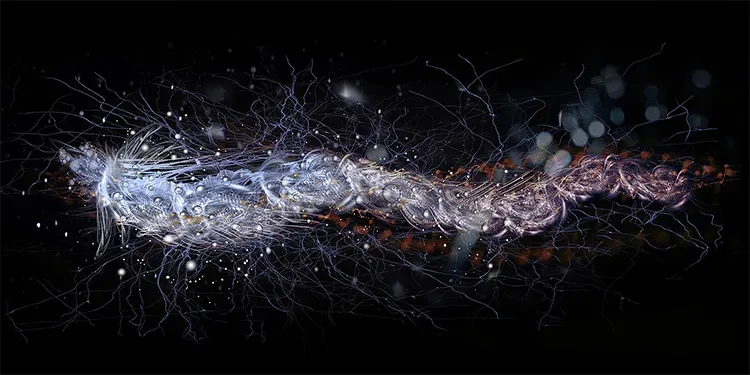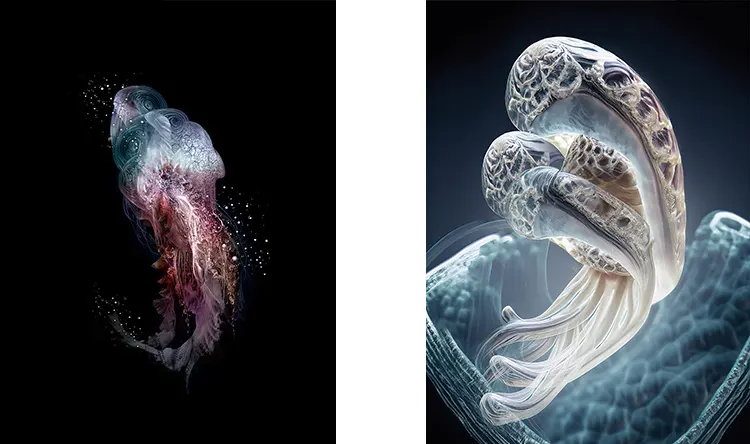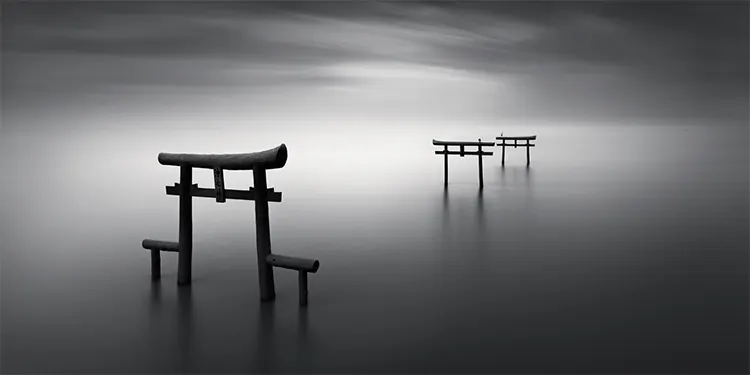“I have made it a habit to look at every event as a form, at a high level of abstraction.”
Delicate Transition: Eriko Kaniwa’s Evolution in Artistry
Eriko Kaniwa is a self-taught digital artist whose oeuvre is deeply rooted in her experience with photography and digital editing. There was a pivotal juncture in her life when she grappled with an identity crisis, a phase that altered significantly as she delved into macro photography of flora within her garden’s nurturing environment. Through the lens, Kaniwa became utterly captivated by the profound interplay of forms orchestrated by the natural realm and the vast cosmos. This transformative encounter nurtured a heightened conceptualization of events as abstract forms, a perspective that has steadfastly endured within her.
Surprisingly, embracing the title of an “artist” was not a deliberate decision for Kaniwa. The thematic explorations and mediums she engages with, spanning photography to digital art, have evolved organically over time. Her foray into the vibrant art community initiated with the submission of her masterpieces for accolades, where she received extensive recognition. This recognition further blossomed when her work was showcased on prestigious platforms like GQ and Vogue.
Currently, Kaniwa is diving deep into her art studies at the University of the Arts. She’s eyeing postgraduate studies as her next step. Her main research theme is exploring how the concept of ‘origins’ been represented as a visual image in art. Managing the triad of artistic production, academic endeavors, and family care presents its challenges. However, the wisdom accrued with age has imbued Kaniwa with a fervent desire to boldly utilize her time, enriching her life and craft with every passing moment.

Eriko Kaniwa: Crafting Microcosms and Unveiling Realms
Eriko Kaniwa’s artistic expression seamlessly weaves abstract and figurative forms, primarily through the avenue of digital editing—a characteristic notably amplified in recent times. The era of the pandemic ignited a contemplative exploration into the symbiotic liaison between humans and microorganisms, subsequently birthing series such as “Neo Primitive Life” and “Parasite”. These particular series navigate the imaginative domains of fictional micro-organisms, reflecting Kaniwa’s ardent pursuit to unveil a concealed realm that harmoniously melds with our palpable reality.
Within the sanctum of Kaniwa’s workspace, music emerges as an indispensable component, orchestrating the ambiance based on thematic inclination. However, once swept into the realm of creation, all external distractions effortlessly dissolve. The fountain of inspiration for Kaniwa’s oeuvre springs from a plethora of sources. An avid reader, Kaniwa finds herself frequently enraptured by discourses on biology, aesthetics, and philosophy. Visually, she harbors an affinity for the surrealistic endeavors of maestros such as Hans Bellmer or Max Ernst, and also finds resonance in the intricacy of ink and Japanese paintings. Encounters with artworks, whether esteemed or obscure, that echo her thoughts, evoke a profound resonance within her. A recent dalliance with an AI-generated abstract image unveiled a newfound reverence for the abstract ideation potential nestled within Artificial Intelligence, further expanding the horizon of Kaniwa’s artistic venture.

The Resonance of Form: Exploring the Organic through Digital Veil
A particularly treasured piece by Eriko Kaniwa is a simplistic black-and-white photograph of a Romanesco vegetable, emblematic of the mathematical and systematic essence embedded within nature’s design. Though infrequently showcased, this piece accentuates the unseen, intricate formations inherent even within our corporeal selves, encouraging a more discerning appreciation for organic forms as sophisticated, life-supporting structures. Through this photograph, Kaniwa elucidates her conviction that an image can communicate eloquently, transcending a mere thousand words.
The segue from photography to digital art marked a natural evolution in Kaniwa’s creative journey, unlocking avenues of expression unattainable through mere photography. Occasionally, the outcomes, surpassing her expectations, surprise the artist. Furthermore, Kaniwa engages in experimental endeavors with water-based pigments, capturing their essence on metal plates or through microscopic lenses, which aids in material creation, thereby adding another dimension to her exploratory artistic narrative.

Sacred Expedition: “JOKEI: Capturing Japan’s Sacred Nature”
Discovering the Scenic and Spiritual Story in “JOKEI: Capturing Japan’s Sacred Nature,” Eriko Kaniwa explores the philosophical domain of nature worship blending the celestial with the earthly in Japanese tradition. With keen artistry and captivating long-exposure photography, Kaniwa explores the sacred core of natural sites across Japan. This 18-month expedition takes Kaniwa to over twenty spiritually enriched places, reflecting Shintoism’s deep respect for nature. Witness enchanting tales through iconic torii gates, mystical “wedded rocks,” and honored World Heritage sites.
In the pages of this award-winning photobook, you’ll journey through a mesmerizing narrative where each photo is more than a simple snapshot; it’s an artistic awakening. With a unique editing style, Kaniwa transforms these photos into fine art masterpieces. Each image combines vivid imagery with touching text, recounting the ancient Japanese admiration for nature-invoking landscapes that spurred spirituality and reflection. Celebrated black-and-white photographer, Joel Tjintjelaar praises this work, highlighting its artistic and spiritual resonance, and urging modern souls to revisit the natural reverence cherished by our forebears.
The narrative extends to captivating series like the Tancho—Japanese Crane and the Flying Eagle, providing not just a visual feast but an in-depth exploration of the spiritual synergy between nature and Japanese culture. These series echo the theme of “Pure Lands” or Jokei in Buddhism, offering a heartfelt glimpse into ancient Japan’s nature bond, before modern technology masked the simple yet profound allure of natural existence.
Published by Japan Create in 2017, this bilingual, 96-page hardcover is more than a book; it’s a portal to a detailed exploration of spirituality and nature in Japanese culture. It encourages readers to not just observe, but to reflect and interact with the sacred tie that seamlessly connects the natural with the spiritual, the earthly with the divine, advocating a deeper appreciation for this enduring connection.

Eriko Kaniwa: Journeying through Japan’s Spiritual Landscape
Continuing her spiritual exploration of Japan, Eriko Kaniwa’s earlier project on photographing ‘Floating Sanctuaries‘ and “Sacred Trees” was just an introduction to this larger narrative. The “Spiritual Landscape of Japan” project showcased the charm of torii gates on tranquil waters and revered trees in sacred shrines, reflecting life’s subtle symbolism through Japanese ethos.
Now, with a focus on extending this inspiring series, Kaniwa directs her lens towards the ancient script of Kanji, aiming to uncover the animistic tales embedded within the rich tapestry of the Japanese psyche. This new endeavor opens magical conversations between the old and the modern, enhancing the intricate mix of cultural, spiritual, and artistic tales. Through this envisioned exploration, Kaniwa strives to narrate the profound stories deeply ingrained in her homeland’s ancestral spirit, capturing the essence of a cultural spiritual narrative that resonates through time.






